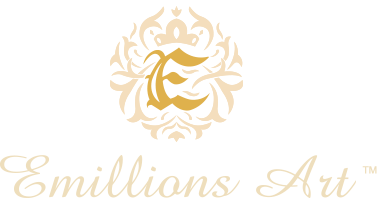We love to hear stories of art collectors in bloom — and we hear plenty! But we also know that a review of some basic tips when starting your art collecting journey are always welcomed!
At Emillions Art, we know many of our readers are intrigued by the thought of investing in fine art but don’t know the pitfalls, the tips and tricks to getting started.
While the variables are many, the biggest thing to remember is, if you love the piece you’re looking at, it’s hard to go wrong. Even so, here are our top six tips to remember when starting your investment art collection.
Know what you love and why you love it
You know you. You know what you’re attracted to — what mediums, colors and moods make you swoon. But do you know why you love them? Can you communicate intelligently to a friend or colleague what you love about those wonderful works?
We think it’s a good idea to build a vernacular, a vocabulary around your feelings for the pieces that set your art loving heart to palpitations. In doing so, you’ll find others who can teach you more about them as well. The journey may even help you know yourself better as a person!
Emanation: Blinded by the Light Magenta (2018) by Clovis Blackwell at the Beverly Hills artSHOW, where the artist has won top awards.
Read, Visit, Learn
Now, here’s a trick that might seem obvious once stated, but many overlook. Before you begin your investment hunt, buy some comprehensive art books. Guides and histories can be just the thing to round out your understanding of the various styles and artists you will be looking at when you start your buying journey.
Visit your local galleries and art fairs. If you can’t get to Art Basel in Miami, you can go to art events in your hometown that range from city-level art fairs to smaller district shows. Don’t skip those! Even though they seem like small, neighborhood events, these are exactly the types of art gatherings that draw and exhibit emerging and just under-the-radar artists and where you’ll discover just what you like. Since these are most likely juried art events, that means the artist and works have gone through a judging phase, so you can make sound decisions on beginning investments in art. A bonus is that if the art catches your eye, you can speak to the artist directly at these events.
This knowledge will help you more quickly determine if a particular dealer or gallery has what you’re looking for at a price that makes sense. As you gain more understanding, you’ll feel more confident as you shop.
Experience, plus education, equals expertise
Which brings us to our next tip. While, there will always be someone who knows more, your encyclopedic knowledge of fine art and artists will help you establish yourself in your own context as the person you can trust to make good investment decisions.
The more you experience, the more you educate yourself, the closer you become to being an expert in the field of art investment. And that’s a good thing! The more expertise you gain, the more confident you will be. Still, there may be times when contacting an industry expert — an art investment professional — may be a wise move.
In this case, remember: Emillions Art is here for you. Always feel free to reach out to us and ask for our input as you start you new endeavor. We love being a part of your journey!
It’s not a name game
Listen, fine art has always had a certain allure for those who wish to be associated with high society. But, really, it’s not about opulence, decadence or influence — it’s about heart. There are wonderful works by masters who’ve become household names — but also by those of whom few will ever hear.
Don’t get distracted by the notion that you need to have a master’s name in your collection. Do your research, find what’s trending — but don’t forget to listen to your instincts. We’ve said it before and we’ll say it again. Discover what you love and buy those works that move you. If your investment collection—besides its value—doesn’t stir your soul, what’s really the point?
It’s ok to buy online
Really! Once you’ve gone to galleries and auction houses, museums and studios, you’ll start to have a really good idea of what you’re looking for. When you shop online, remember to look for the sellers credentials. Look for reviews of other buyers.
Look for the volume of traffic or sales. Look for small things — the attention to detail on the website — the artist’s biographies — have they been kept up to date? These may seem like trivial nuances, but they are all small clues to the finesse and genteel touch of the broker or consultant from whom you are purchasing.
Beware the basics before you buy
They may seem trivial and pedestrian, but these are a few important details you’ll want to think through. Pablo Picasso himself said, “The purpose of art is washing the dust of daily life off our souls” — and it’s true. But, before bringing your new work of art home, make sure your home or renter’s insurance will cover its value.
You may need to buy additional coverage. As crass as this may seem, it would be horrendously unfortunate if you were to make it all the way through this process only to have your experience punctuated by a catastrophic end. Damaged or stolen art is difficult to replace, so make sure you — and it — are covered!
Also, be careful where you put your new haul. If the work could fade, make sure to hang it away from direct sunlight. In the case of an over-abundance of natural light, it may not be a bad decision to find a darker space where you can install lighting to enhance the experience of your art — or just let the work be its own luminescence!
Now, sit back and enjoy your art.






